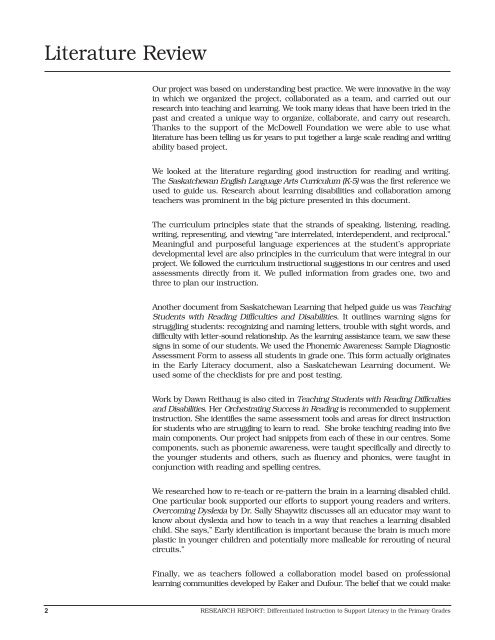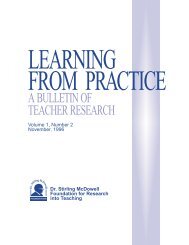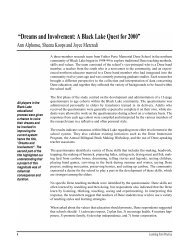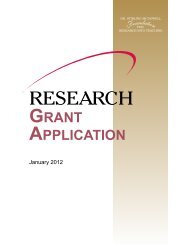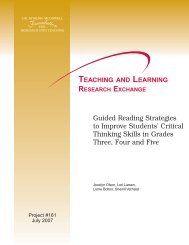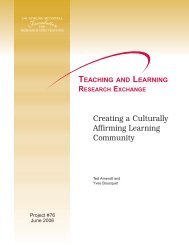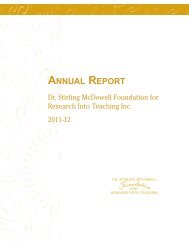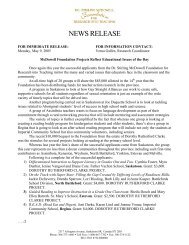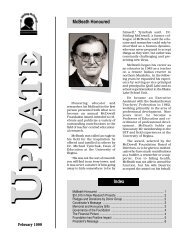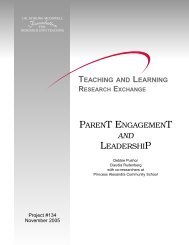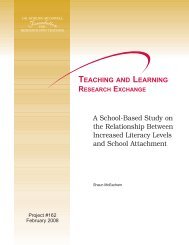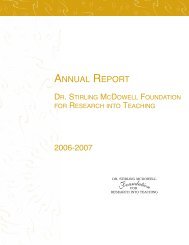Differentiated Instruction to Support Literacy in the Primary Grades
Differentiated Instruction to Support Literacy in the Primary Grades
Differentiated Instruction to Support Literacy in the Primary Grades
You also want an ePaper? Increase the reach of your titles
YUMPU automatically turns print PDFs into web optimized ePapers that Google loves.
Literature Review<br />
Our project was based on understand<strong>in</strong>g best practice. We were <strong>in</strong>novative <strong>in</strong> <strong>the</strong> way<br />
<strong>in</strong> which we organized <strong>the</strong> project, collaborated as a team, and carried out our<br />
research <strong>in</strong><strong>to</strong> teach<strong>in</strong>g and learn<strong>in</strong>g. We <strong>to</strong>ok many ideas that have been tried <strong>in</strong> <strong>the</strong><br />
past and created a unique way <strong>to</strong> organize, collaborate, and carry out research.<br />
Thanks <strong>to</strong> <strong>the</strong> support of <strong>the</strong> McDowell Foundation we were able <strong>to</strong> use what<br />
literature has been tell<strong>in</strong>g us for years <strong>to</strong> put <strong>to</strong>ge<strong>the</strong>r a large scale read<strong>in</strong>g and writ<strong>in</strong>g<br />
ability based project.<br />
We looked at <strong>the</strong> literature regard<strong>in</strong>g good <strong>in</strong>struction for read<strong>in</strong>g and writ<strong>in</strong>g.<br />
The Saskatchewan English Language Arts Curriculum (K-5) was <strong>the</strong> first reference we<br />
used <strong>to</strong> guide us. Research about learn<strong>in</strong>g disabilities and collaboration among<br />
teachers was prom<strong>in</strong>ent <strong>in</strong> <strong>the</strong> big picture presented <strong>in</strong> this document.<br />
The curriculum pr<strong>in</strong>ciples state that <strong>the</strong> strands of speak<strong>in</strong>g, listen<strong>in</strong>g, read<strong>in</strong>g,<br />
writ<strong>in</strong>g, represent<strong>in</strong>g, and view<strong>in</strong>g “are <strong>in</strong>terrelated, <strong>in</strong>terdependent, and reciprocal.”<br />
Mean<strong>in</strong>gful and purposeful language experiences at <strong>the</strong> student’s appropriate<br />
developmental level are also pr<strong>in</strong>ciples <strong>in</strong> <strong>the</strong> curriculum that were <strong>in</strong>tegral <strong>in</strong> our<br />
project. We followed <strong>the</strong> curriculum <strong>in</strong>structional suggestions <strong>in</strong> our centres and used<br />
assessments directly from it. We pulled <strong>in</strong>formation from grades one, two and<br />
three <strong>to</strong> plan our <strong>in</strong>struction.<br />
Ano<strong>the</strong>r document from Saskatchewan Learn<strong>in</strong>g that helped guide us was Teach<strong>in</strong>g<br />
Students with Read<strong>in</strong>g Difficulties and Disabilities. It outl<strong>in</strong>es warn<strong>in</strong>g signs for<br />
struggl<strong>in</strong>g students: recogniz<strong>in</strong>g and nam<strong>in</strong>g letters, trouble with sight words, and<br />
difficulty with letter-sound relationship. As <strong>the</strong> learn<strong>in</strong>g assistance team, we saw <strong>the</strong>se<br />
signs <strong>in</strong> some of our students. We used <strong>the</strong> Phonemic Awareness: Sample Diagnostic<br />
Assessment Form <strong>to</strong> assess all students <strong>in</strong> grade one. This form actually orig<strong>in</strong>ates<br />
<strong>in</strong> <strong>the</strong> Early <strong>Literacy</strong> document, also a Saskatchewan Learn<strong>in</strong>g document. We<br />
used some of <strong>the</strong> checklists for pre and post test<strong>in</strong>g.<br />
Work by Dawn Reithaug is also cited <strong>in</strong> Teach<strong>in</strong>g Students with Read<strong>in</strong>g Difficulties<br />
and Disabilities. Her Orchestrat<strong>in</strong>g Success <strong>in</strong> Read<strong>in</strong>g is recommended <strong>to</strong> supplement<br />
<strong>in</strong>struction. She identifies <strong>the</strong> same assessment <strong>to</strong>ols and areas for direct <strong>in</strong>struction<br />
for students who are struggl<strong>in</strong>g <strong>to</strong> learn <strong>to</strong> read. She broke teach<strong>in</strong>g read<strong>in</strong>g <strong>in</strong><strong>to</strong> five<br />
ma<strong>in</strong> components. Our project had snippets from each of <strong>the</strong>se <strong>in</strong> our centres. Some<br />
components, such as phonemic awareness, were taught specifically and directly <strong>to</strong><br />
<strong>the</strong> younger students and o<strong>the</strong>rs, such as fluency and phonics, were taught <strong>in</strong><br />
conjunction with read<strong>in</strong>g and spell<strong>in</strong>g centres.<br />
We researched how <strong>to</strong> re-teach or re-pattern <strong>the</strong> bra<strong>in</strong> <strong>in</strong> a learn<strong>in</strong>g disabled child.<br />
One particular book supported our efforts <strong>to</strong> support young readers and writers.<br />
Overcom<strong>in</strong>g Dyslexia by Dr. Sally Shaywitz discusses all an educa<strong>to</strong>r may want <strong>to</strong><br />
know about dyslexia and how <strong>to</strong> teach <strong>in</strong> a way that reaches a learn<strong>in</strong>g disabled<br />
child. She says,” Early identification is important because <strong>the</strong> bra<strong>in</strong> is much more<br />
plastic <strong>in</strong> younger children and potentially more malleable for rerout<strong>in</strong>g of neural<br />
circuits.”<br />
F<strong>in</strong>ally, we as teachers followed a collaboration model based on professional<br />
learn<strong>in</strong>g communities developed by Eaker and Dufour. The belief that we could make<br />
2 RESEARCH REPORT: <strong>Differentiated</strong> <strong>Instruction</strong> <strong>to</strong> <strong>Support</strong> <strong>Literacy</strong> <strong>in</strong> <strong>the</strong> <strong>Primary</strong> <strong>Grades</strong>


